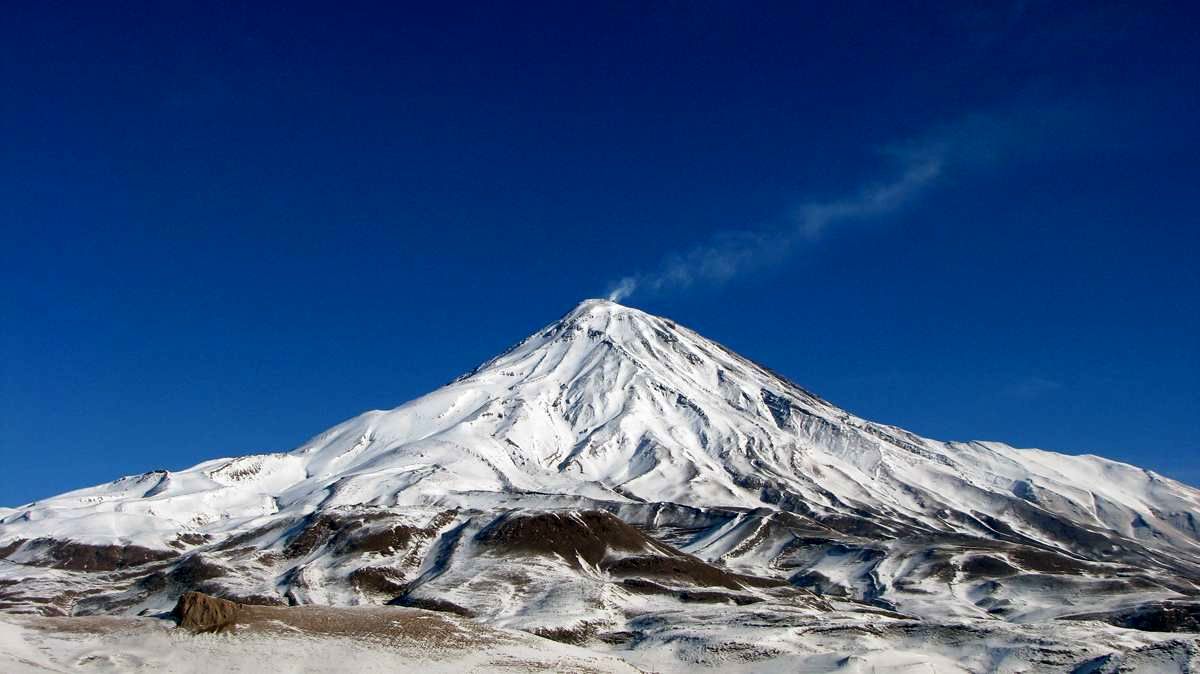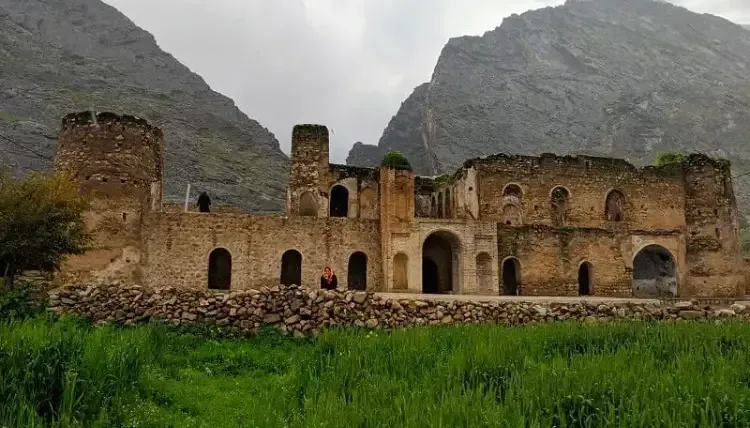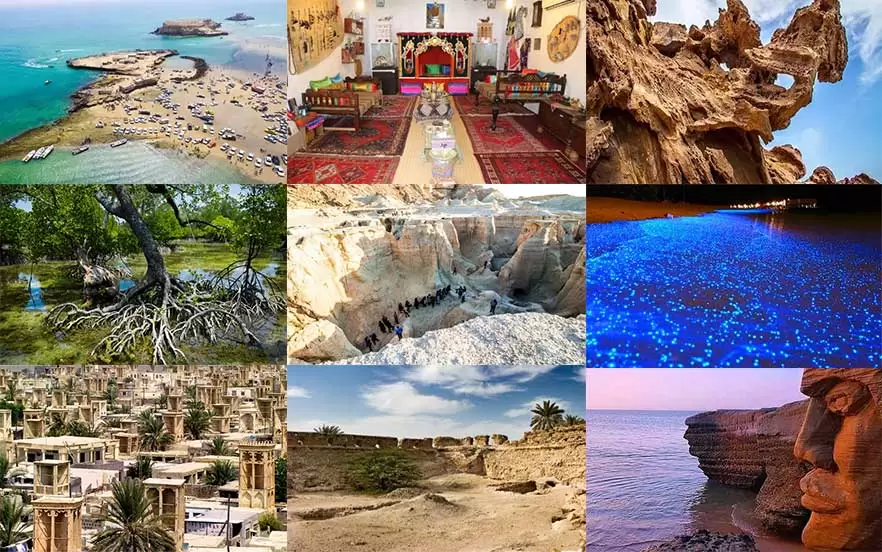Mount Damavand: A Majestic Peak in Iran
Mount Damavand, towering majestically in the Alborz mountain range, holds a significant place in Iranian history and culture. Renowned for its rich biodiversity and unique plant species, Damavand is not only a natural gem but also a symbol of national pride. Historical accounts of ascent claims date back to figures like Abolghasem Khozravi, with documented successful European ascents in 1837. As an active volcano with thermal springs, Damavand attracts adventurers and nature enthusiasts alike. Explore the mystique of Damavand through its history, diverse flora, and the challenges it poses for climbers.Join us on Gulf Citypedia to discover everything you need to know about Mount Damavand .
Mount Damavand’s Location:
Mount Damavand is situated in the central part of the Alborz mountain range, south of the Caspian Sea, within the Larijan district of Amol city in Mazandaran province, Iran. Recognized as the highest volcanic peak in Iran and the Middle East, it was registered as the country’s first natural heritage site in July 2008. Since 2001, Damavand has also held the status of a national natural monument, acknowledging its environmental significance. The mountain has long been a symbol of grandeur and magnificence for Iranians, featuring prominently in the nation’s literature and history, as well as Persian myths.
Geography of Mount Damavand:
As the tallest volcano in Iran and the Middle East, Mount Damavand stands as an iconic landmark in the Mazandaran province. Its majestic presence is visible from Tehran, Varamin, Qom, and the Caspian Sea on clear, sunny days.
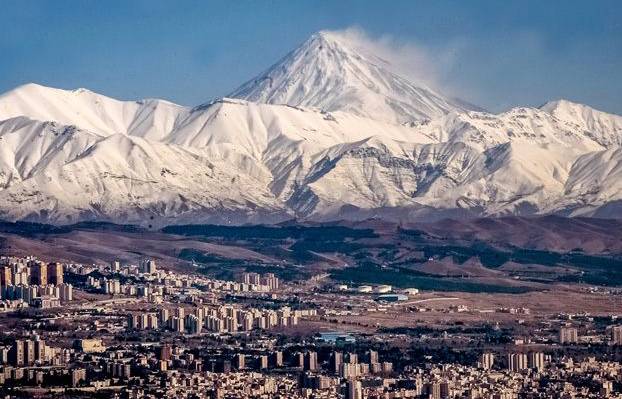
Historical Significance of Mount Damavand:
Mount Damavand has a rich historical significance, deeply rooted in Iranian literature and history. It has been a focal point in Persian myths and tales, symbolizing greatness and grandiosity.
Places of Interest around Mount Damavand:
The beautiful landscapes surrounding Damavand make it a popular destination for tourists. The region offers breathtaking views, and the mountain itself is an attraction for climbers and nature enthusiasts.
Damavand as a Volcano:
Mount Damavand is not only the highest peak in Iran but also an active volcano. While it hasn’t erupted in recent history, its volcanic nature adds to the allure of the mountain.
Vegetation and Wildlife of Mount Damavand:
The flora and fauna on Mount Damavand are adapted to the harsh mountainous environment. The mountain is home to a variety of plant and animal species, contributing to its ecological importance.
Mount Damavand in Iran’s Natural Heritage:
Recognized as a national natural monument, Mount Damavand holds a special place in Iran’s natural heritage. Efforts are made to preserve and protect the environment around the mountain.
Historical Ascents of Mount Damavand:
Mount Damavand has been a challenge and goal for many climbers throughout history. Various historical figures and groups have made ascents to its summit, contributing to the mountain’s cultural and historical significance.
Access Routes to Mount Damavand:
The city of Damavand and Tehran are primary access points for those interested in climbing Mount Damavand. Different ascent routes are available, with the southern route being the most popular. Shelter facilities along the routes provide accommodation for climbers, and guides are available to assist in the ascent.
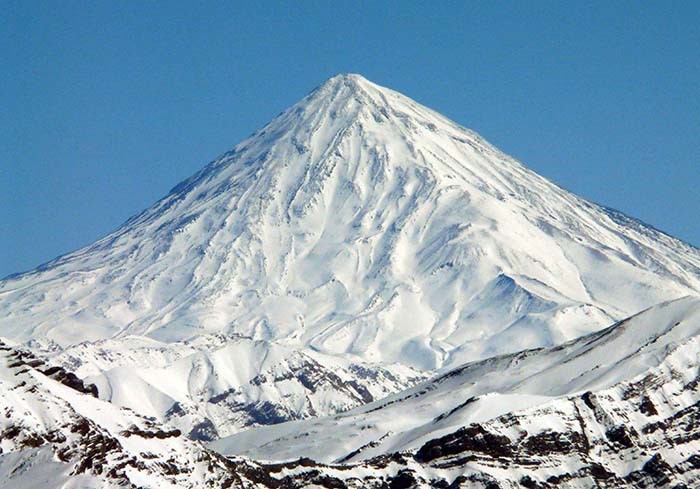
Height of Mount Damavand:
Mount Damavand ranks twelfth among the world’s highest peaks in terms of relative height. According to national and international databases, its elevation is approximately 5,670 meters.
Climate on Mount Damavand:
The climate on Mount Damavand varies significantly with low temperatures, especially in winter. The summit experiences half the atmospheric pressure of sea level, with temperatures dropping as low as -60 degrees Celsius in winter and approaching freezing in summer. The average annual precipitation in the Damavand region is around 1,400 millimeters, primarily falling as snow at higher elevations.
Mount Damavand, with its natural beauty, cultural significance, and challenging ascent, continues to be a symbol of pride and admiration for Iranians and a captivating destination for nature lovers and adventurers worldwide.
Mount Damavand in History
Historical References:
The Assyrians referred to Mount Damavand as the “Kan-e Sang-e Lajvard” (the Sapphire Stone Mountain). During the Assyrian rule, this mountain was considered part of the Median territory on the Iranian plateau, as mentioned in Assyrian texts. Deaconov suggests that the burial of the dead in mountains, such as Damavand, was a Magian ritual practiced by the Mags who lived in the vicinity of Damavand and spread their customs to other parts of Iran. Numerous prehistoric graves are found in the foothills of Damavand. In the 8th century AD, there was a Zoroastrian temple called “Mas-Maghan” at the base of Mount Damavand, where Zoroastrian Mobads named Mas-Maghan and his followers resided. This temple was destroyed by the order of the Abbasid Caliph Al-Mahdi, and Mas-Maghan was killed. Throughout different periods of Iranian history, including the Pahlavi era, Mount Damavand and the radiance of the sun behind it were utilized as symbols of the Iranian land.
Name and Etymology:
The name Damavand is recorded in two forms, Damavand and Denavand. It has also been referred to as Bikani and Jabal Lajvard. The origin of the name Damavand is explained as “Dam (steam, vapor) + Avand = Damavand,” meaning having steam, smoke, and vapor (volcano). Nasir Khusraw, a Persian traveler and writer, mentioned Damavand in his early travelogue, associating it with the city of Lavasan.
Damavand in Myths and Literature:
In Iranian myths, Damavand plays a significant role. One notable tale involves Feridun imprisoning the tyrant Zahhak in a cave on Mount Damavand, where Zahhak remains until the end of time when he will break free and bring about destruction. Some locals still believe that Zahhak is imprisoned on Damavand, and the sounds heard from the mountain are his moans. This myth is also echoed in Ferdowsi’s Shahnameh.
Places of Interest around Mount Damavand:
One of the remarkable features near Damavand is the unique frozen waterfall in the southern front. This 7-meter high and 3-meter diameter waterfall never melts, and its frozen state is maintained even in the summer. The area surrounding Damavand is also dotted with numerous natural wonders, including glaciers with names like Siuleh, Dobisal, Aroosakha, Yekhab, Shomal Gharbi, and Gharbi.
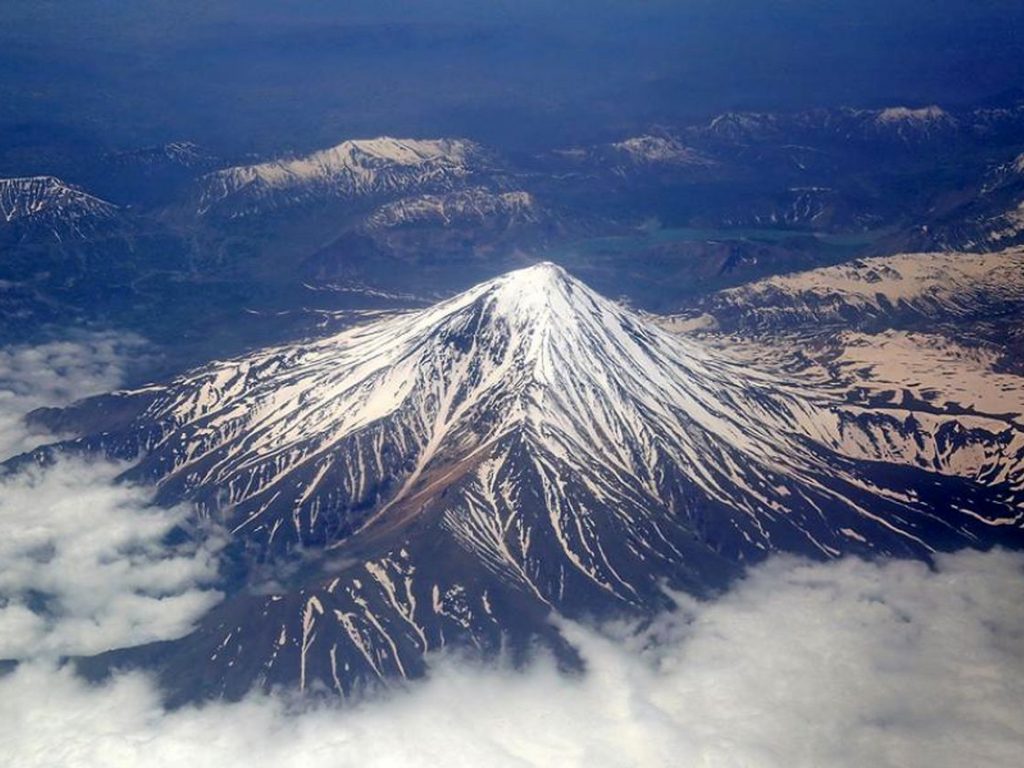
Damavand as a Volcano:
Damavand is categorized as a semi-active volcano, formed during the Holocene epoch, around 38,500 years ago. Evidence of its semi-active state includes several sulfur springs and hot water sources. The most significant volcanic activity occurred approximately 10,000 years ago. Damavand’s volcanic mouth has a diameter of around 400 meters, covered by a glacier.
Beliefs about Damavand’s Volcanic Activity:
Opinions differ on whether Damavand is an active volcano. Some argue that it is not, while others, like Dr. Mehdi Zare, consider Damavand to be an active volcano, pointing to the emission of gas and hot springs as signs of its activity.
Mount Damavand, with its rich history, cultural significance, and unique geological features, continues to capture the imagination of people, standing as a symbol of Iran’s natural beauty and mythical tales.
Mount Damavand in History
The Assyrians referred to Mount Damavand as “Kan Sange Lajvard” (the mountain of azure stone). During the Akkadian and Elamite periods, it was considered part of the Median territory on the Iranian Plateau. Assyrian texts also mention it during this time. Deaconov suggests that the tradition of placing the dead on mountains was a Magian ritual practiced by the Moghan people who lived in the foothills of Damavand, spreading their practices to other parts of Iran. In the foothills of Damavand, there are numerous prehistoric graves. In the 8th century AD, there was a Zoroastrian fortress called “Dezh” at the foot of Mount Damavand, where the Zoroastrian priest Masmaghan and his followers lived. This fortress was destroyed on the orders of Al-Mahdi, the Abbasid caliph, and Masmaghan was killed. During the Pahlavi era and at various times in Iranian history, Mount Damavand and the shining sun behind it were used as symbols of the Iranian land.
Name and Etymology
The name Damavand has two variations: Damavand and Denavand. The mountain is also known by entirely different names such as Bikeni and Jabal Lajvard. The etymology of the name Damavand is explained in Moein’s dictionary as follows: dam (smoke, vapor) + āvand = Damavand; meaning having smoke, steam, and vapor (volcano).
Naser Khosrow Qobadiani, a Persian traveler, mentioned Damavand in the early years of his travelogue:
Between Ray and Amol is Mount Damavand, like a dome called Lavasan.
Lavasan in Middle Persian means the mountainous region where the sun rises. The Damavand myth is also present in Iranian myths. In Persian literary works, Damavand is often referred to in connection with the myth and, more generally, Mount Damavand.
Its fame is mainly associated with the myth of Feridun, a legendary figure in Iranian mythology, who imprisoned Zahhak there in a cave until the end of time. Some residents near Damavand still believe that Zahhak is imprisoned in Damavand, and they believe that some of the sounds heard from the mountain are his groans. According to another narrative, the battle between Feridun’s army and Zahhak took place near Damavand.
According to Balamiri’s history, the residence of Keyumars’ son, Qiumars, is Mount Damavand, and his son’s grave is located there. Damavand is mentioned again during the reign of Manuchehr; Arash Kamangir shot an arrow from its summit to determine the border between Iran and Turan.
In ancient Iranian poems, Damavand’s name is usually associated with the myth of Zahhak being bound. Ferdowsi, in the Shahnameh, describes the story of Zahhak being bound by Feridun on Damavand:
- Take this bound to Mount Damavand
- Let it remain forever, unblemished
In other poems and compositions by other poets, including Naser Khosrow, the Vis and Ramin by Fakhr al-Din As’ad Gorgani, and a poem by Khaghani, hints of this myth can be seen. The second Damavandi poem, composed in 1301 by Malek al-Sho’araye Bahar, is a famous poem about Damavand, and its lines include:
- O white demon, with your foot in chains!
- O dome of power! O Damavand!
Sights around Mount Damavand
Waterfall
In the southern front of Mount Damavand, there is a unique frozen waterfall mentioned in various texts. Its height is 7 meters, and its diameter is 3 meters, with the ice never melting. In the summer, due to sunlight around noon and an hour later, the air temperature rises above zero, causing a very small amount of water to flow. Around 4 p.m., the air temperature drops below zero again, and the melted ice refreezes; thus, a frozen ice waterfall always forms. There is a gorge above this waterfall, covered with snow throughout the year. Mount Damavand’s ice waterfall, located at an altitude of 5,100 meters, is the highest waterfall in the Middle East in terms of elevation from sea level.
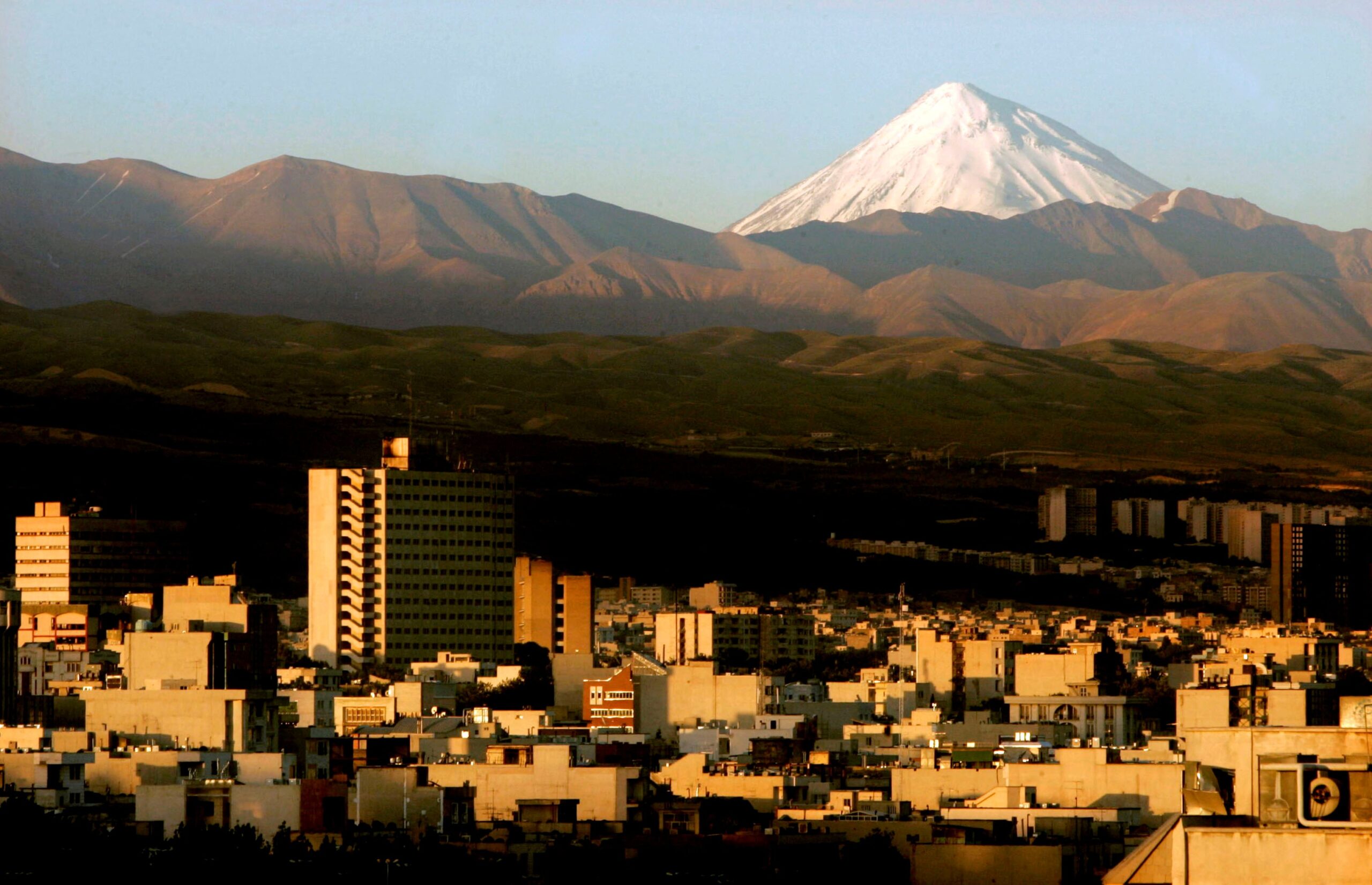
Glaciers
The natural glaciers known as Damavand glaciers are as follows:
- Sivuleh Glacier (north front)
- Doobi Sall Glacier (north front)
- Aroosakha Glacier (north front)
- Yekhchal Darre Yekhar (northeast)
- Khortab Sarr Glacier
- Northwest Glacier
Damavand Volcano
Mount Damavand is a semi-active stratovolcano formed during the Holocene epoch. It was formed during the fourth geological era, known as the Holocene, and is estimated to be at least 38,500 years old using carbon-14 dating. Several sulfur springs and hot springs are evidence of its semi-active status. Most of its significant volcanic activity, which shaped the mountain, occurred around 10,000 years ago. The diameter of its crater is approximately 400 meters, covered by a glacial lake.
Some people argue that Damavand is not a volcano, but others believe it is an active volcano because of the gas emissions and hot springs. Dr. Mehdi Zare, an expert, is among those who believe Damavand is an active volcano.
Flora and Fauna of Mount Damavand
The vegetation in this area is rich, with many medicinal plants mentioned in reputable botanical books. Various plants grow at different altitudes on Mount Damavand, and some are unique to specific elevations. Some of the Damavand-named plants include Damavand Hat, Damavand Kozel, Damavand Bumadran, Damavand Piregia, Damavand Gosheh, Damavand Forget-me-not, Damavand Zangulehi, Damavand Ketani, and Damavand Mashk.
Some types of thorny shrubs on Damavand include Damavand Hat, thorn bush, various thorny species like Gavun, and many others found in the eastern foothills.
Other types of Damavand plants include Alpine Fir, Semi-spherical Spruce, Gavun, Rocky Jasmine, Koushek Kohsari, Persian Rockrose, Kohsari Tarragon, Daghdeghak Alborzi, Booti Shrub, Grape Galosh, Taare Gol, Wild Jasmine, Caucasian Rose, Weed, Goatgrass, Aristida, Central Asian Foxtail Grass, Bami Rush,
Red Grass, Mountain Barley, Milkweed, Water Avens, Pink Poppy, Shokrteghal, and Mashhadi Shokrteghal, Joun Jasir, Sarish, and in moist areas, Gold Tongue.
Mount Damavand’s foothills, at elevations between 2000 and 3500 meters, are covered entirely with poppies. This unique poppy is known globally as the “poppy of Lar” and “Rineh poppy,” registered in reputable world botanical books. This region is also rich in pasture and grazing, and even in the high altitudes of Damavand (below 4000 meters), there is no significant lack of pasture. Unfortunately, overgrazing, mining, road construction, and tourist waste have seriously endangered the Shaghayegh fields of Damavand.
Due to its unique location, Mount Damavand hosts various types of animals. Four-legged predators like foxes, jackals, dogs, and wolves are scattered around Damavand. These animals can be observed up to an altitude of 4000 meters. Bears also live in this area but are more commonly found in the west and north, avoiding higher altitudes.
Herbivorous animals such as wild goats, sheep, deer, gazelles, and rabbits are also found on Damavand. Except for gazelles and rabbits, which live in the foothills of Mount Damavand, other animals spend the warm seasons at higher altitudes and gradually descend with the cooling weather. These animals can go up to 5000 meters.
Birds of prey such as golden eagles, owls, and bats are present. Other birds in this area include vultures, quails, thrushes, and dark-capped tits.
Several types of snakes, scorpions, toads, various mice families, and shrews are seen in this region. Most of the snakes in this area are non-venomous, and even the bites of the most dangerous snakes are treatable within a few hours. In the mountains of Damavand, snakes are rarely seen above 4000 meters.
Mount Damavand’s Role in Iran’s Natural Heritage
Mount Damavand is a symbol of stability, strength, and national pride in Iranian culture. It has been registered as a national monument and is celebrated and remembered in various ways. The peak of Damavand was registered as the first Iranian natural monument in the list of Iranian national monuments in 2008.
Registration of Mount Damavand as a National Natural Monument
Mount Damavand, with an area of over 2950 hectares, was included in the protected areas under the management of the Environmental Protection Organization by the decree number 221 on 21/03/81 of the Supreme Council of Environment. Mount Damavand, with a geographical latitude of 35° 57′ 19″ N and a longitude of 52° 06′ 33″ E, is located in the northeast of Tehran, in Mazandaran Province. Significant plant species include Bumadran, Piregah Damavandi, Fir Alpine, and Gavun. Over-exploitation of the environment’s tolerable capacity and the extraction of quarry materials around this national natural monument are among the most significant threats to its destruction.
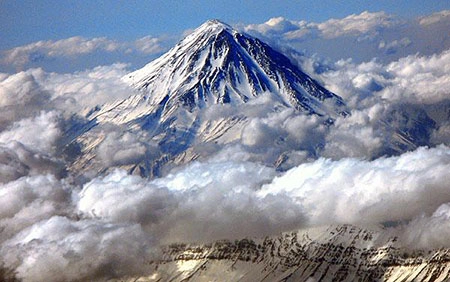
National Damavand Day
National Damavand Day is celebrated simultaneously with Tirgan in Mazandaran under the name “Tir Maah Sizdah Sho” on the night of the thirteenth of Aban (the fifth month of the Iranian calendar). The Iranian Mountaineering Federation holds this celebration every year in the Damavand area in the city of Rineh Larijan, Amol County. This celebration is also nationally registered. The national music of Damavand, performed by Salar Aghili, was unveiled during the Tirgan celebration in 2012 and was attended by around 9,000 people.
In the past hundred years, the image of Mount Damavand has been printed several times on official Iranian banknotes.
Historical Claimants of Mount Damavand Ascent
The first person who claimed to have ascended Mount Damavand was Abolqasem Khazarji. In his travelogue, he made a reference to his ascent and provided a description of the Damavand peak. Following him, individuals such as Qazvini, Masudi, Ibn Fakih, and Naser Khosrow also made references to the location of Damavand. In ancient times, some claimed to have reached the summit of Damavand. Naser Khosrow wrote in his travelogue:
They say there is a well on top of Damavand from which sulfur and brimstone are extracted.
The first successful documented ascent by Europeans of Mount Damavand took place in 1837 by Taylor Thomson. Additionally, the first documented Iranian ascent of the peak dates back to 1857 when a team led by Colonel Mohammad Sadegh Khan conquered it.
If you have experienced climbing or even photographing Mount Damavand, be sure to share your experiences with other users on Koojaro.
Frequently Asked Questions
1. In which province is Damavand located?
Damavand is located in the Larijan district of Amol County in the Mazandaran Province, according to the country’s administrative divisions.
2. What are the other names for Damavand?
Damavand is registered under two variations of its name: Damavand and Denavand. This mountain is also known by entirely different names such as Bikeni and Jabal Lajvard.
3. Is Damavand an active volcano?
Damavand is considered a semi-active stratovolcano, with evidence of gas emissions and hot springs indicating its semi-active status.
4. When is National Damavand Day?
National Damavand Day is celebrated simultaneously with Tirgan in Mazandaran under the name “Tir Maah Sizdah Sho” on the night of the thirteenth of Aban (the fifth month of the Iranian calendar).

